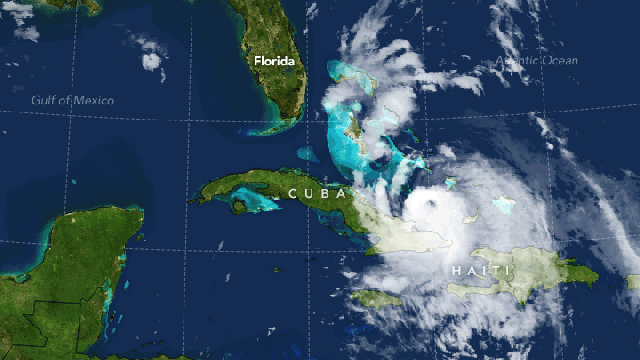There is no doubt that Hurricane Matthew is an exceptionally nightmarish storm. Unfortunately, it’s exactly the sort of nightmare that’s expected to become more familiar in a warmer world.
Image: NASA Earth Observatory
A little over a week ago, Matthew was a nameless tropical depression. It didn’t cause much stir when it intensified into a tropical storm. But then, it proceeded to shock meteorologists by growing into a Category 5 monster in just 36 hours, becoming one of the three most rapidly intensifying storms in Atlantic hurricane history.
This week, Matthew became the first Category 4 hurricane to make landfall in Haiti since 1964. It became the longest-lived Category 4-5 hurricane in the eastern Caribbean on record. It became the longest-lived major (Category 3 or higher) Caribbean hurricane in over a decade. And today, it could become the strongest storm on record to make landfall north of West Palm Beach. Whether or not the eye of the storm actually strikes the land, Matthew has already prompted one of the largest evacuations on US soil.
No storm is directly our fault, unless you believe that the Air Force has a mind-controlling weather machine. But the more carbon humans add to the atmosphere, the more we’re going to tip the scales in favour of rapidly-intensifying, long-lived, extremely powerful storms like Matthew.
“There’s very simple physics that states as you warm the atmosphere, there’s more water vapour that can be condensed into rain,” MIT climate scientist Kerry Emanuel told Gizmodo. Warmer surface waters can also feed more energy into storms, allowing them to retain their intensity for longer. For these reasons, we expect to see the frequency of high-intensity storms go up.
Finding that warming signal in the real world isn’t easy. The data is messy, spotty and, in many cases, inadequate. There are confounding factors, like decadal climate oscillations, and regional temperature rebounds after we clean up air pollution.
Still, there are signs that globally, a warming signal is beginning to emerge, through an uptick in the most high-intensity storms. And in the north Atlantic, nearly every metric of hurricane activity — from the frequency, intensity and duration of large storms, to the number of Category 4 and 5 monsters — has increased since the mid 1980s.
Our tools for pulling out a climate change connection to individual weather events — a field called “weather attribution” — are also rapidly improving. Last month, a NOAA-led attribution study concluded that August’s record Louisiana floods were made at least 40 per cent more likely by human-caused global warming. Put another way, a downpour that used to occur on the Gulf Coast every 50 years is now expected to recur every 30 years.
Whether a similar attribution study will be conducted for Hurricane Matthew remains to be seen. But here’s what we know. Last year was the warmest our oceans have ever been. This year, the oceans are likely to be warmer. Right now, ocean surface temperatures in the Caribbean are at near-record levels. Warmth provides energy that intensifies storms.
You could call this a collection of unfortunate coincidences, or quibble about uncertainties and noise in the data. But to do so is to ignore the bigger picture — that by warming the planet, we are changing the context of every meteorological event moving forward. We are loading the dice.
“Matthew is up there in the pantheon of long-lived, high category events,” Emaneul said. “And we do expect to see more of those in the future.”
